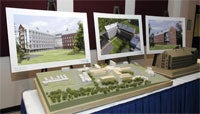 KINGSTON, R.I. — September 14, 2005 — University of Rhode Island officials gave an overview to members of the state’s leading media outlets last week of their plans to transform the north district of the Kingston Campus into a hub for health science, research and technology.
KINGSTON, R.I. — September 14, 2005 — University of Rhode Island officials gave an overview to members of the state’s leading media outlets last week of their plans to transform the north district of the Kingston Campus into a hub for health science, research and technology.
During the second annual Back to School Media luncheon hosted by the URI Department of Communications/News Bureau, URI Vice President for Administration Robert Weygand presented architectural renderings, a scale model of the new Center for Biotechnology and Life Sciences, for which voters approved a $50 million bond issue in 2004, and a model of the north district development.
During the next four years, the University expects to link the Center for Biotechnology and Life Sciences to three new buildings that will house academic programs in pharmacy, nursing and chemistry and form a health sciences quadrangle adjacent to Flagg Road. By constructing adjacent buildings for academic programs with similar needs, efficiencies can be designed to facilitate the sharing of laboratory space and equipment and to encourage interaction among program personnel and students.
University officials will seek approval of a $140 million bond issue to be placed on the ballot for the fall 2006 election for the three additional buildings. The briefing led to a front-page story in The Providence Journal by Jennifer Jordan, a segment on the Channel 10 news by reporter/anchor Kelly McGee and a piece the following day on Channel 10’s News at Sunrise with Frank Coletta. Other media outlets planned coverage of the north district plan as well.
“Science and technology have been a part of the University for virtually its entire life,” Weygand said. “What we are proposing is a campus to bring all of our science and technology curricula together in one physical space. We are creating a quadrangle that will serve as a hub for the health life sciences.”
Health care has had to move to a model of collaboration, and no longer can nurses, pharmacists, doctors and other professionals operate in their separate silos, said Donald Letendre, dean of the College of Pharmacy. Because of the increasing complexity of the health care environment and an aging population, health care professionals are now working together more and more. Currently, the Colleges of Nursing and Pharmacy are on opposite sides of the campus, making collaboration a challenge.
“It is essential that health care professionals work together. At URI, we have the knowledge and the intellect, and now we need the tools,” Letendre said.
Jeffrey Seemann, dean of the College of Environment and Life Sciences, told the group that the new biotechnology center is the largest single academic building project in the history of public higher education, in the state.
“We have in Kingston this wonderful quadrangle with its stately granite buildings, but this will be the new quadrangle for the 21st century,” Seemann said.
Here are some key elements of the health sciences hub:
— College of Pharmacy: The proposed 150,000-square-foot building would replace Fogarty Hall, the college’s current home, which was built when pharmacy enrollment was 150. The building now does not adequately accommodate 580 students and over 80 faculty and staff. A new building would enhance URI’s ability to increase the number of students and retain leading researchers, as well provide a compelling reason for existing and start-up companies to enhance their businesses.
— College of Nursing: The proposed 50,000-square-foot building would include laboratories, classrooms, clinical practice areas, research space and faculty offices. Its location next to the pharmacy building would promote efficient use of clinical training and treatment spaces and encourage interdisciplinary research and teaching initiatives. The current nursing shortages have forced the college to enroll many more students than the colleges current home, White Hall, can handle.
— Department of Chemistry: The current chemistry building, Pastore Hall, was built in 1952 and is overcrowded and outdated. Chemistry classes provide the foundation for courses in pharmacy, nursing and biotechnology, as well as in many other environmental, science and engineering fields. Chemistry teaching and research facilities have advanced greatly since Pastore was built, and current research and safety protocols require highly evolved technical systems. A new building would house teaching and research laboratories, classrooms and offices.
— Center for Biotechnology and Life Sciences: This 150,000-square-foot facility has already been approved by voters and is in the design stage. As a center of education and research, it will drive economic development in the state’s growing biotechnology industry. It will house modern classrooms, high-tech specialty laboratories, instrumentation, faculty offices, incubator space for technology commercialization and a 400-seat auditorium.
Media Contact: Dave Lavallee, 401-874-5862

